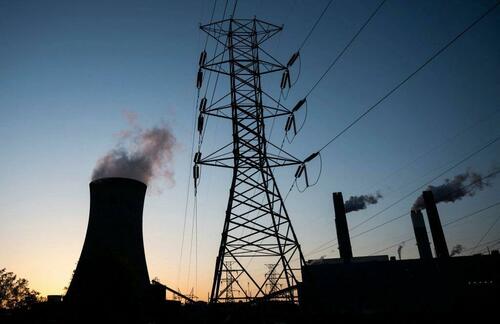Authored by Tom Ozimek via The Epoch Times (emphasis ours),
An increasing number of American households are falling behind on their utility bills as energy costs remain elevated heading into winter, according to a new analysis from two nonprofits.

Past-due balances owed to electric and gas utilities have climbed from $597 to $789 over the past three years—a 32 percent jump that a Nov. 17 report from The Century Foundation and Protect Borrowers says is an indication of growing financial strain on millions of American households.
“Rising utility costs are already taking a toll on family finances,” the report states.
“The Century Foundation and Protect Borrowers’ analysis of consumer credit data shows an avalanche of household utility debt has been building over the past three years.”
The two nonprofits predicted that the utility-debt situation “will likely worsen” in the coming months.
Millions Facing Severe Delinquency
The analysis, which draws on data from the University of California Consumer Credit Panel, estimates that nearly one in 20 households—about 14 million people—now have utility debt severe enough that it has been or will soon be sent to collections. In parts of the South and Appalachia, where collection practices tend to be harsher, that figure is closer to one in 12.
Most of the 32 percent increase in overdue utility debt cited in the report took place under President Joe Biden, but the pace of increase has yet to flatten under President Donald Trump. During the first six months of Trump’s second term, the number of households with severely overdue utility debt increased by approximately 117,000, representing a 3.8 percent rise.
“Our findings paint a grim picture: a toxic combination of increasing energy prices, rising overdue balances, and squeezed household budgets that together are pushing families deeper and deeper into debt,” the report states.
“For many Americans, higher heating costs this winter could be the tipping point.”
Over the past year, past-due balances on utility bills climbed by nearly 10 percent. Monthly energy bills rose even faster, jumping by 12 percent year over year and 35 percent over the past three years—nearly triple the pace of overall inflation.
No part of the country has been spared. Average monthly bills exceed $300 in parts of the Northeast, but heavy cooling demand has pushed costs in Arizona ($289), California ($303), Texas ($269), and much of the Southeast into similarly high territory. The analysis notes that its data precede the peak heat of summer 2025, meaning current bills are likely even higher.
Political Backdrop and White House Response
The utility debt surge comes amid ongoing efforts by the Trump administration to address the cost-of-living crisis that has plagued the country and was a key pain point for many voters in the 2024 presidential election.
The president plans to discuss the economy and affordability issues on Nov. 17 at an event hosted by McDonald’s. He has repeatedly stated that inflation is falling.
“In fact, costs under the TRUMP ADMINISTRATION are tumbling down, helped greatly by gasoline and ENERGY. Affordability is a lie when used by the Dems. It is a complete CON JOB,” Trump wrote in a Truth Social post on Nov. 14.
The current annual inflation rate sits at 3 percent, lower than the peak of 9 percent notched in June 2022. Still, inflation remains above the Federal Reserve’s 2 percent target, and central bank officials have said that the fight against price pressures has not yet been won.
Despite that progress has been made on the cost-of-living front, consumer optimism has fallen in recent months, driven in part by affordability concerns.
At the beginning of November, consumer sentiment was at a three-year low, the decline fueled by a 17 percent drop in perceptions of current personal finances and an 11-point decline in expectations for year-ahead business conditions.
Loading recommendations...